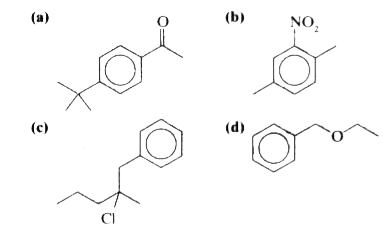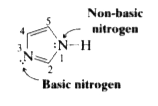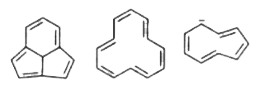Complete Solutions to Solved Problem of chapter AROMATIC COMPOUNDS of Class 12 book with complete answers and questions
| Class 12 | CHEMISTRY |
| Chapter | AROMATIC COMPOUNDS |
| MS CHOUHAN | Solved Problem |
| Number Of Questions | 48 |
| Academic Year | 2023-24 |
Provide a name for each of the following compounds.

View SolutionUsing the polygon-and-circle method to outline the molecular orbitals of cyclobutadiene. Explain cyclobutadiene is not aromatic.
View SolutionImidazole (at right) has two nitrogens, N3 is relatively basic (like the nitroge of pyridine). N1 is relatively non-basic (like the nitrogen of pyrrole). Explain the different basicities of these two nitrogens.

View SolutionDesignate whether each of the following compounds is aromatic, non-aromatic or anti-aromatic.

View SolutionDesignate whether each of the following compounds is aromatic, non-aromatic or anti-aromatic.

View SolutionDesignate whether each of the following compounds is aromatic, non-aromatic or anti-aromatic.

View SolutionDesignate whether each of the following compounds is aromatic, non-aromatic or anti-aromatic.

View SolutionDesignate whether each of the following compounds is aromatic, non-aromatic or anti-aromatic.

View SolutionDesignate whether each of the following compounds is aromatic, non-aromatic or anti-aromatic.

View SolutionDesignate whether each of the following compounds is aromatic, non-aromatic or anti-aromatic.

View SolutionDesignate whether each of the following compounds is aromatic, non-aromatic or anti-aromatic.

View SolutionDesignate whether each of the following compounds is aromatic, non-aromatic or anti-aromatic.

View SolutionIn the given compound, will Br ionize in the form of (a) `Br^(-)` or (b) `Br^(+)`.

View SolutionThe given compound has high dipole moment. Explain.

View SolutionExplain why the given compound undergoes dimerization at room temperature and readily reacts with active metals.

View SolutionCompare the rate of reaction of the following compounds with `AgNO_(3)`.

View SolutionClassify each as aromatic, anti-aromatic and non-aromatic compound.

View SolutionClassify each as aromatic, anti-aromatic and non-aromatic compound.

View SolutionClassify each as aromatic, anti-aromatic and non-aromatic compound.

View SolutionClassify each as aromatic, anti-aromatic and non-aromatic compound.

View SolutionClassify each as aromatic, anti-aromatic and non-aromatic compound.

View SolutionClassify each as aromatic, anti-aromatic and non-aromatic compound.

View SolutionClassify each as aromatic, anti-aromatic and non-aromatic compound.

View SolutionClassify each as aromatic, anti-aromatic and non-aromatic compound.

View SolutionProvide a name for each of the following compounds.

View SolutionUsing the polygon-and-circle method to outline the molecular orbitals of cyclobutadiene. Explain cyclobutadiene is not aromatic.
View SolutionImidazole (at right) has two nitrogens, N3 is relatively basic (like the nitroge of pyridine). N1 is relatively non-basic (like the nitrogen of pyrrole). Explain the different basicities of these two nitrogens.

View SolutionDesignate whether each of the following compounds is aromatic, non-aromatic or anti-aromatic.

View SolutionDesignate whether each of the following compounds is aromatic, non-aromatic or anti-aromatic.

View SolutionDesignate whether each of the following compounds is aromatic, non-aromatic or anti-aromatic.

View SolutionDesignate whether each of the following compounds is aromatic, non-aromatic or anti-aromatic.

View SolutionDesignate whether each of the following compounds is aromatic, non-aromatic or anti-aromatic.

View SolutionDesignate whether each of the following compounds is aromatic, non-aromatic or anti-aromatic.

View SolutionDesignate whether each of the following compounds is aromatic, non-aromatic or anti-aromatic.

View SolutionDesignate whether each of the following compounds is aromatic, non-aromatic or anti-aromatic.

View SolutionDesignate whether each of the following compounds is aromatic, non-aromatic or anti-aromatic.

View SolutionIn the given compound, will Br ionize in the form of (a) `Br^(-)` or (b) `Br^(+)`.

View SolutionThe given compound has high dipole moment. Explain.

View SolutionExplain why the given compound undergoes dimerization at room temperature and readily reacts with active metals.

View SolutionCompare the rate of reaction of the following compounds with `AgNO_(3)`.

View SolutionClassify each as aromatic, anti-aromatic and non-aromatic compound.

View SolutionClassify each as aromatic, anti-aromatic and non-aromatic compound.

View SolutionClassify each as aromatic, anti-aromatic and non-aromatic compound.

View SolutionClassify each as aromatic, anti-aromatic and non-aromatic compound.

View SolutionClassify each as aromatic, anti-aromatic and non-aromatic compound.

View SolutionClassify each as aromatic, anti-aromatic and non-aromatic compound.

View SolutionClassify each as aromatic, anti-aromatic and non-aromatic compound.

View SolutionClassify each as aromatic, anti-aromatic and non-aromatic compound.

View Solution
Solved Problem questions and complete solutions for chapter AROMATIC COMPOUNDS of MS CHOUHAN CHEMISTRY (HINGLISH) of Class 12
All Exercises from MS CHOUHAN Class 12 CHEMISTRY AROMATIC COMPOUNDS
- Additional Objective Questions (Integer Type)
- Additional Objective Questions (Linked Comprehension Type)
- Additional Objective Questions (Matrix Match Type)
- Additional Objective Questions (Single Correct Choice Type)
- Exercise
- Level 1 (Q.121 To Q.150)
- Level 1 (Q.181 To Q.210)
- Level 1 (Q.31 To Q.60)
- Level 2
- Solved Problem
- Subjective Problems